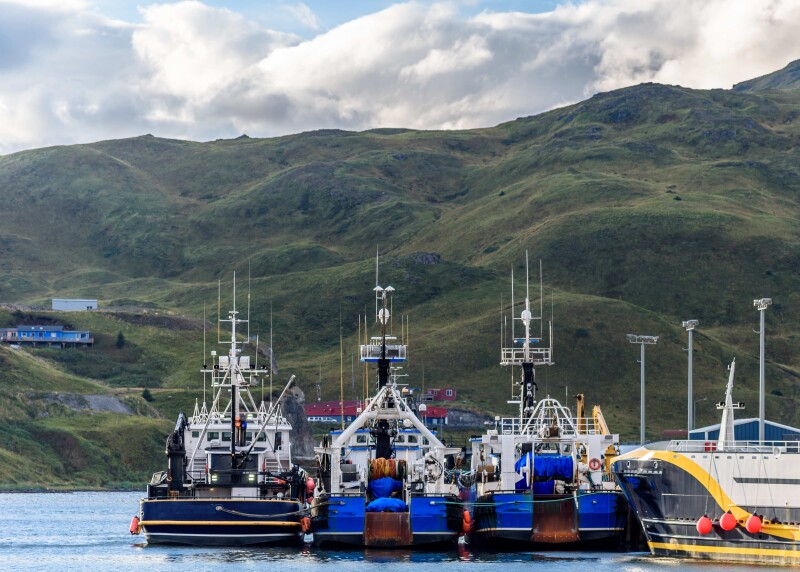For the 25th consecutive year, Dutch Harbor, AK, and New Bedford, MA, ranked as the top U.S. fishing ports for volume and value in 2022.
Nationwide, commercial landings that year were 8.4 billion pounds valued at $5.9 billion, down by 2.6 percent and 11 percent ($632 million), respectively.
Those are two of the top takeaways from the annual Fisheries of the United States report released this month by NOAA Fisheries. The data show a downward press almost across the board from Covid-driven impacts as the global pandemic waned in 2022.
The easy-to-read, 23-page report provides a national snapshot of U.S. commercial fisheries, aquaculture, seafood processing, imports and exports, market trends, and per capita consumption.
Here’s a 2022 overview:
Landings from 2021 to 2022 decreased in all U.S. regions except for the Gulf of Mexico. By state, only California, Connecticut, East Florida, Louisiana, and Mississippi showed modest increases.
Landings at the number one port, Dutch Harbor, totaled 613.5 million pounds, valued at $159.9 million at the docks. That compares to 745 million pounds worth $249 million in 2021.
At New Bedford, deliveries of pricey scallops again produced the nation’s top-valued port, valued at $443.2 million, down from $569.7 million the previous year.
Most valuable catches
Alaska pollock remained the nation’s largest fishery, with landings of 2.7 billion pounds. That was followed by menhaden (1.4 billion pounds), salmon (714.9 million pounds), flatfish (485.8 million pounds), and Pacific cod (402.9 million pounds).
The most valuable species landed in the U.S. were salmon ($827 million), lobsters ($581.3 million), crabs ($570.2 million), Alaska pollock ($513 million), and sea scallops ($466.9 million).
For processed seafood (fillets, fish sticks, canned, etc.), the most valuable item was Alaska pollock ($2.1 billion), sockeye salmon ($1.3 billion), shrimp ($1 billion), tuna ($0.8 billion) and cod ($0.7 billion)
The 2022 average price paid to fishermen was 70 cents per pound, a decrease of 6 cents from 2021.
Aquaculture makes gains; seaweed farming surges
Freshwater and marine aquaculture defied the downward trend in both production and value, estimated at 663 million pounds and $1.7 billion, respectively.
“While aquaculture only accounts for 7 percent of total US seafood production, the focus on high-value products means that 23% of the value of seafood products comes from aquaculture,” the NOAA report said.
Freshwater aquaculture in the US consists primarily of catfish, crawfish and trout. The total volume and value of that segment is pegged at 583 million pounds and $872 million, respectively.
Marine aquaculture includes mostly oysters, clams, and mussels. In 2022, the nation produced 39.4 million pounds of bivalves (meat weight), which had a total value of $318 million.
Farmed seaweed (also referred to as macroalgae) reflected the most growth in 2022, with wet weight topping two million pounds and $1.0 million, respectively – a nearly 30-fold increase in production over the past five years.
“This rapid increase in farmed seaweed production indicates promise that this sector may become an important contributor to U.S. competitiveness in global seafood production,” the report added.
Imports still dwarf U.S. seafood exports
Between 65 percent and 85 percent of seafood consumed by Americans is imported, and the U.S. seafood maintained its imbalance in global trade with an import/export deficit of $24.2 billion, up more than 6 percent from 2021.
In foreign trade, the U.S. imported 6.9 billion pounds of seafood products valued at $29.7 billion. Top items were shrimp, salmon fillets/steaks, whole crabs, whole lobster, and whole salmon. The top U.S. trading partners for imports are Canada, Chile, India, Indonesia and Vietnam.
The U.S. exported 2.5 billion pounds of seafood valued at $5.5 billion. The top-valued exports were whole lobster, surimi, whole sockeye salmon, caviar/roe, and Alaska pollock fillets/steaks. The top markets for U.S. exports are Canada, China, Japan, South Korea, and the Netherlands.
Between 2021 and 2020, U.S. per capita consumption of seafood fell slightly to 19.8 pounds, down from 20.5 pounds the previous year.
The NOAA report also includes data on recreational fishing, which grew from 2021 to 2022.
Oysters make the Top 10 list for the first time
Americans ate 19.7 pounds of seafood per capita in 2022, down 0.8 pounds from 2021.
The latest numbers show a continuation of the “tinned fish” craze featuring increases in consumption of canned tuna, canned shellfish and canned sardines, wrote the National Fisheries Institute which each year publishes the Top 10 list of US favorites.
Shrimp dipped a bit but kept its spot as America’s #1 seafood. Pangasius and cod saw the biggest gains in consumption, and tilapia, catfish and Alaska pollock held their place in the Top 10.
Meanwhile, oysters joined the list for the first time ever.
“The 2022 Top 10 List reflects the correction that took place following the 2021 supply surge which saw a 9 percent increase in available seafood,” said NFI Programs Director Richard Barry.
“Since the previous year experienced record high supply growth, a slight dip the following year was expected. The 2022 per capita number; however, remains higher than pre-pandemic consumption, an encouraging sign of retained seafood consumers,” Barry said.
He added: “The Top 10 List makes up 79 percent of total consumption, which shows that Americans are continuing to diversify their seafood experiences.”







